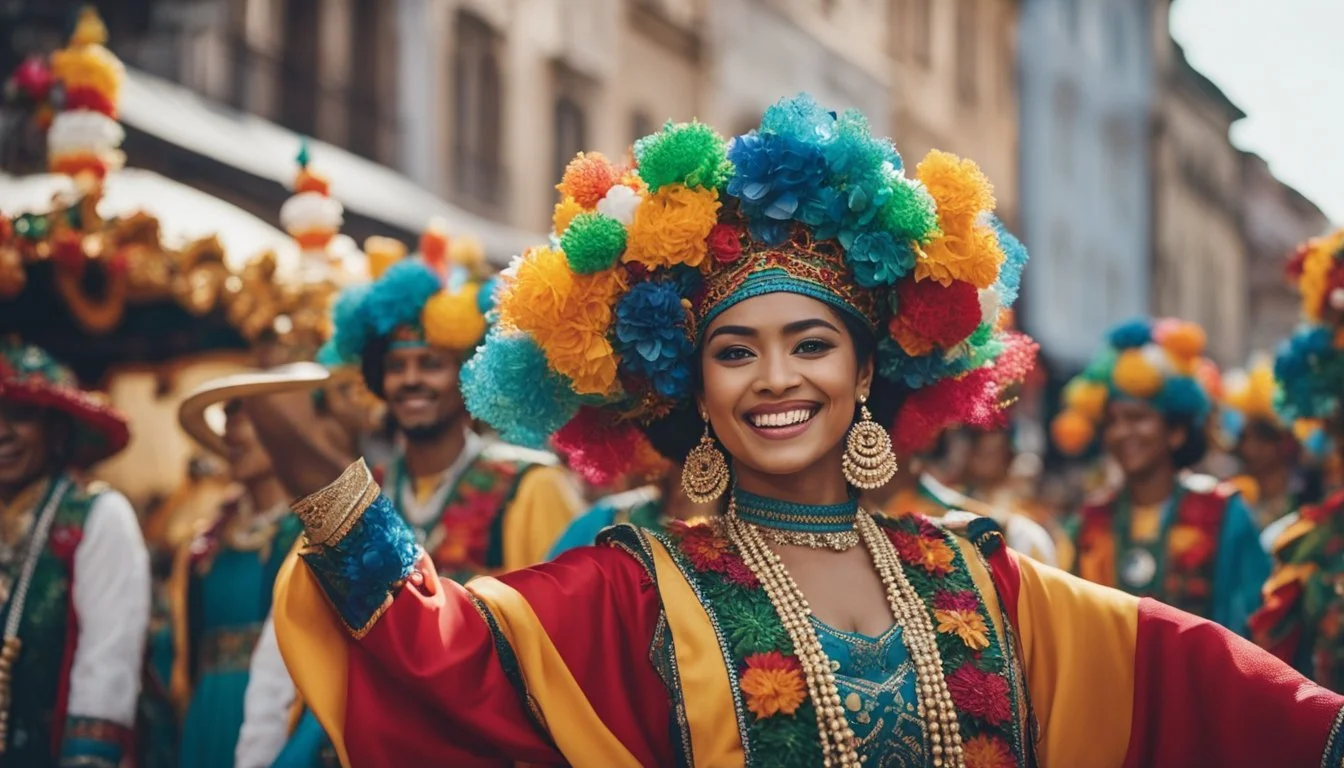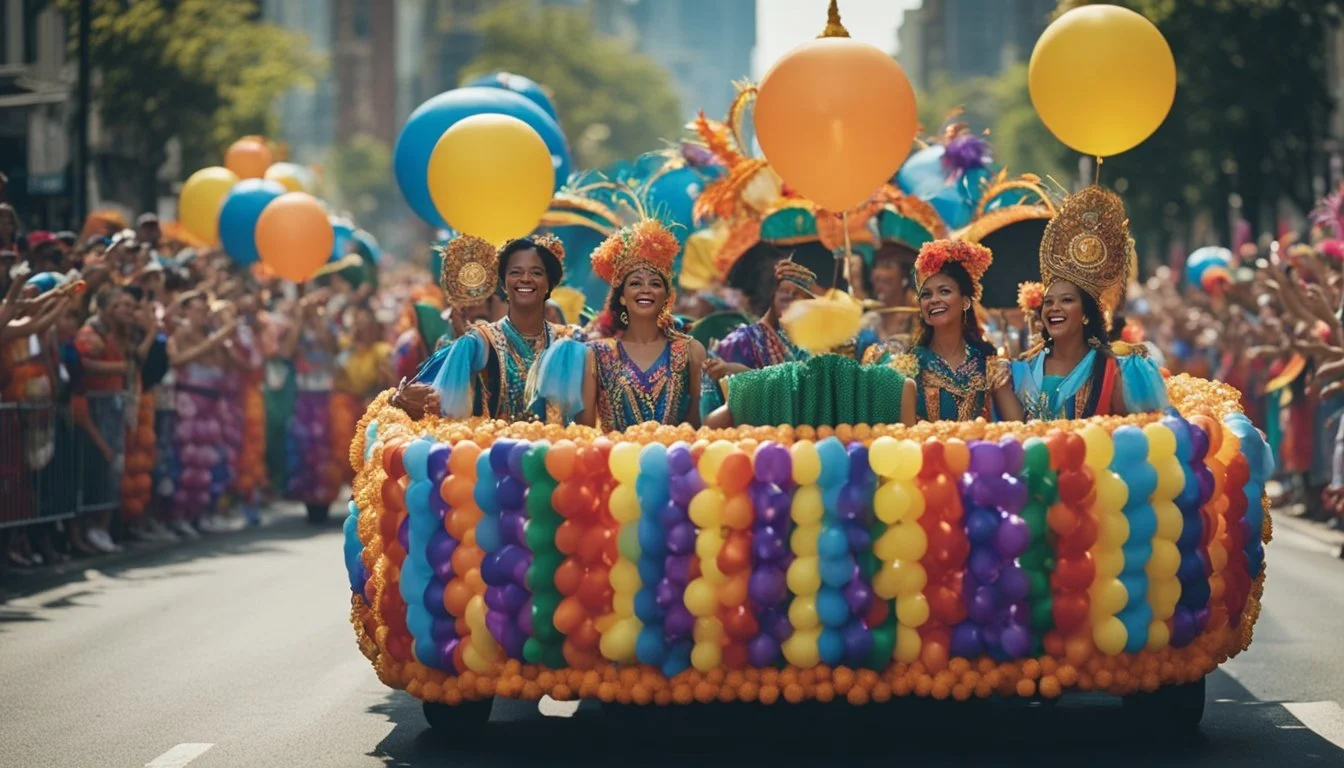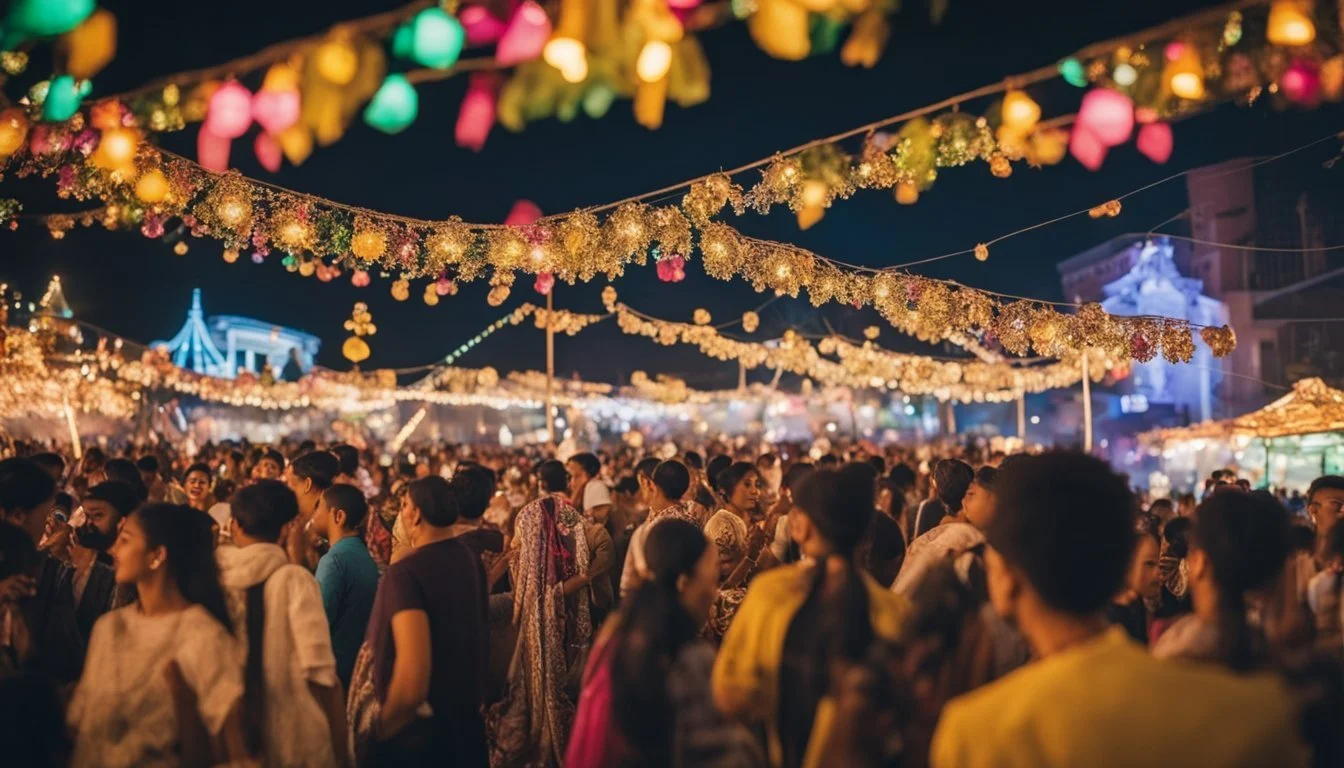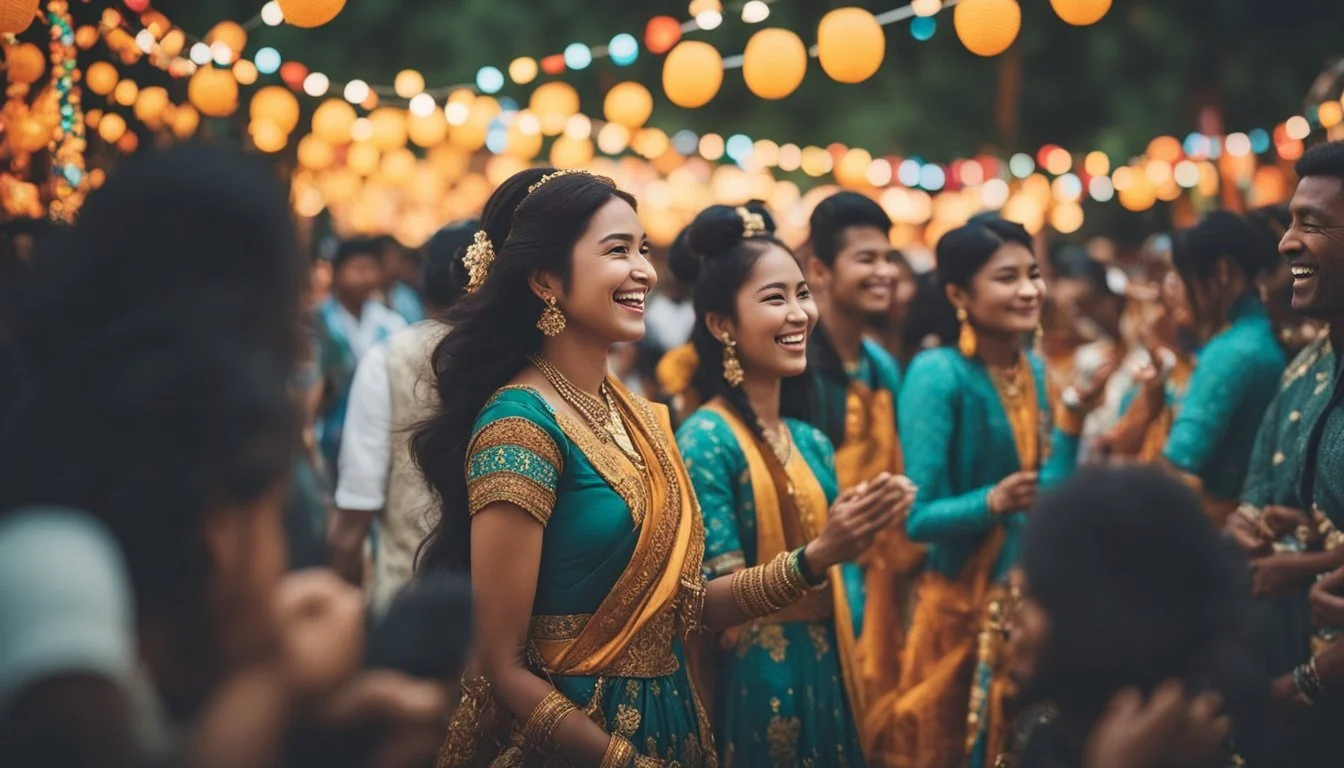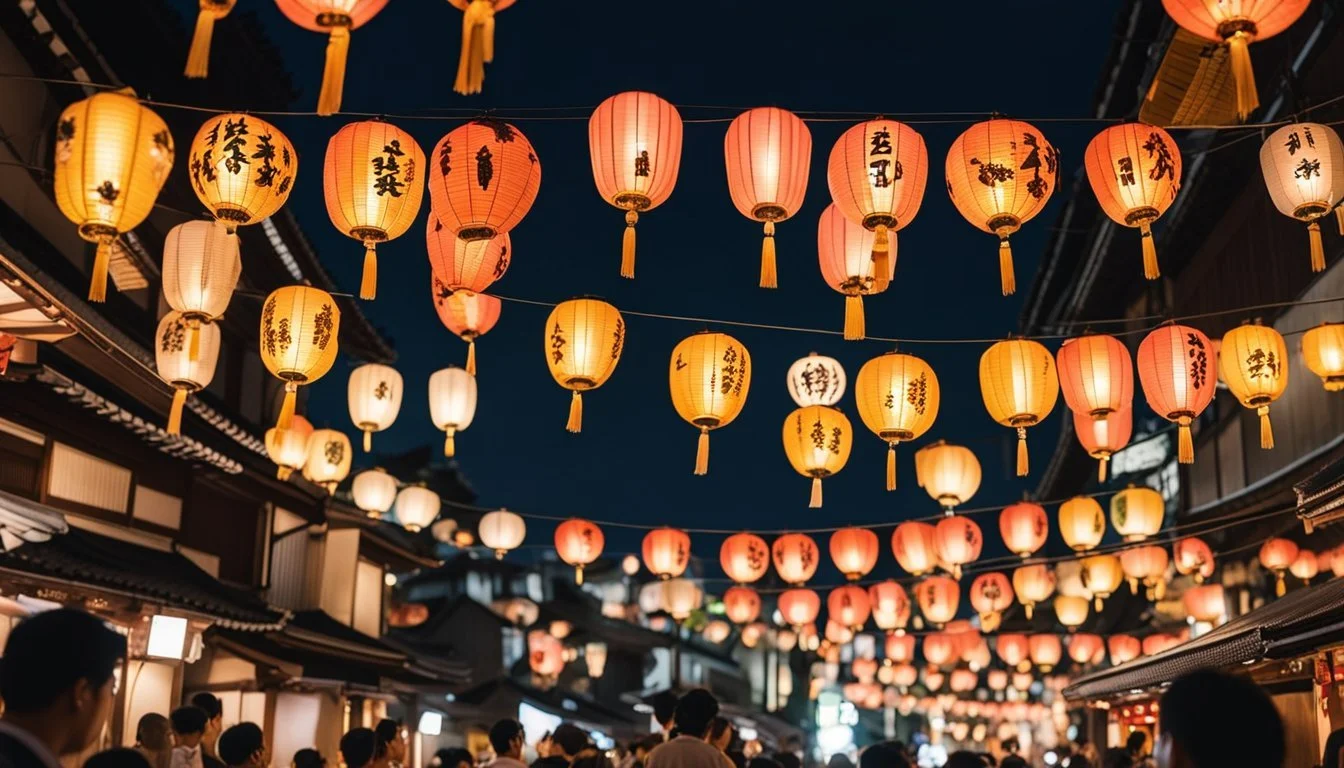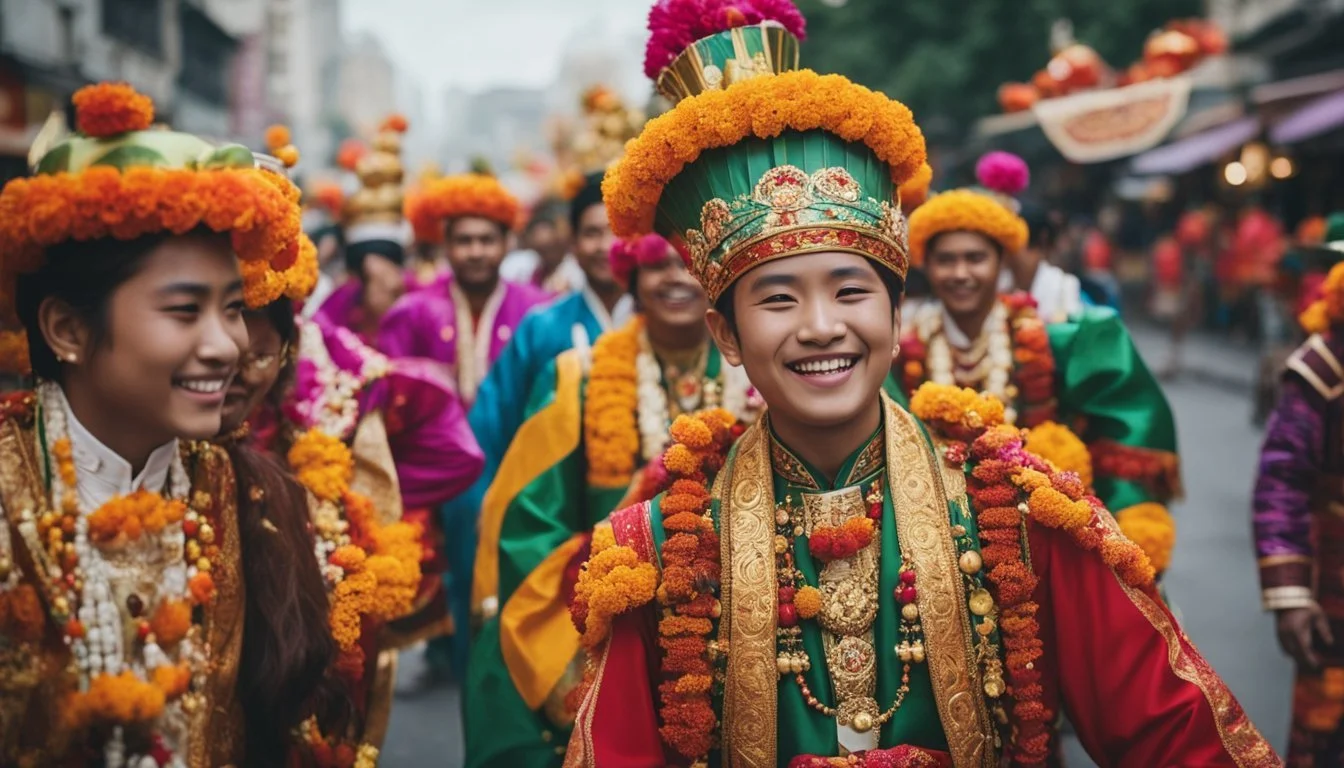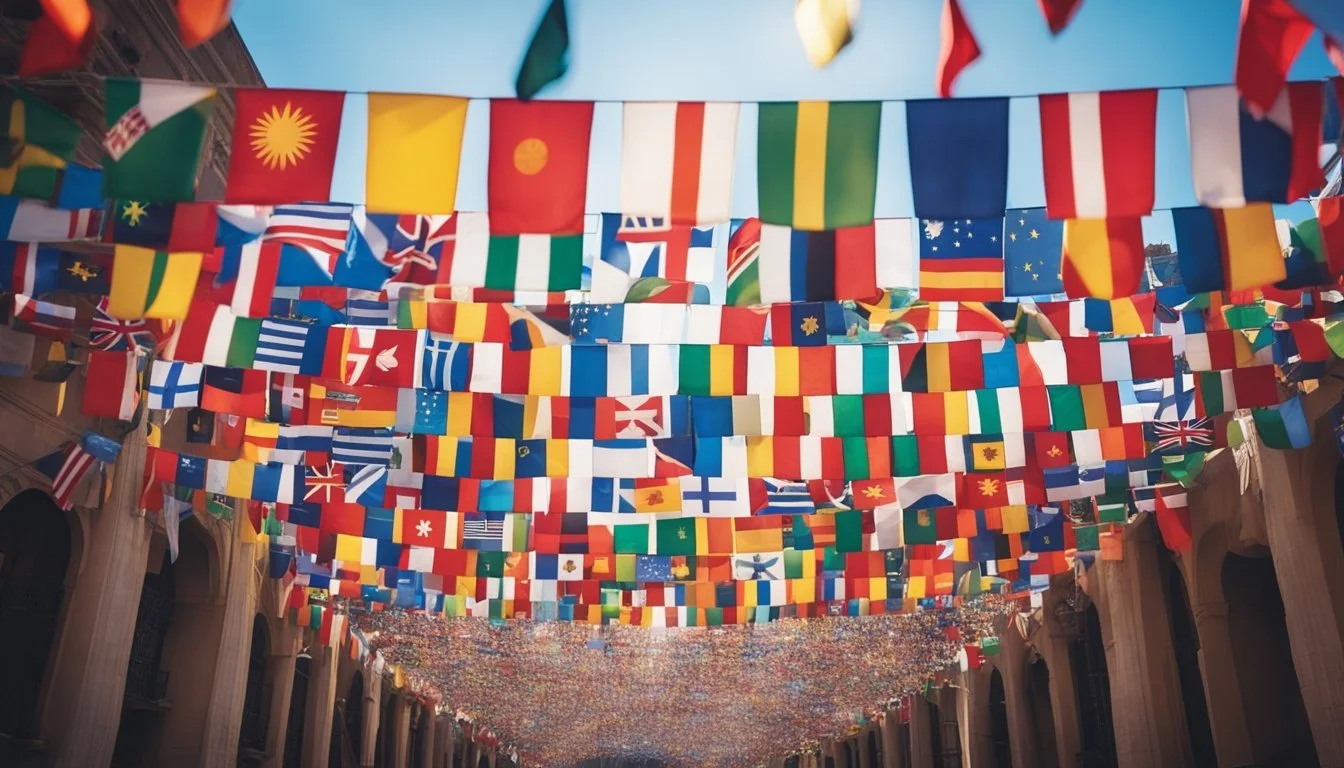20 Cultural Festivals Around the World You Can't Miss
A Global Celebration Guide
Cultural festivals offer a unique glimpse into the heart and soul of communities around the globe. They provide an opportunity to experience rich traditions, vibrant celebrations, and the diverse range of human expression. Whether it's through music, dance, food, or rituals, these festivals connect people across cultures and generations.
Exploring cultural festivals around the world is an enriching way to understand and appreciate the diversity of human traditions. These events often celebrate historical milestones, religious holidays, or seasonal changes, allowing participants to immerse themselves in different cultural practices. From the energetic streets of Rio's Carnival to the colorful celebrations of India's Holi, each festival leaves a lasting impression on those who partake in its unique charm.
1) Rio Carnival
The Rio Carnival in Rio de Janeiro, Brazil, is often regarded as the world's largest and most famous carnival. Taking place in late February to early March, it features vibrant parades, samba music, and dazzling costumes. It marks the beginning of Lent and has deep cultural and religious significance.
One of the main highlights is the Sambadrome parade, where samba schools compete with elaborate floats and performances. Thousands of performers participate, showcasing intricate choreography and colorful attire. The energy and enthusiasm of the participants and spectators is infectious.
Apart from the Sambadrome, street parties, known as blocos, pop up throughout the city. These parties attract locals and tourists alike, creating a festive atmosphere in every corner of Rio. Each bloco has its own unique theme and music style.
The Rio Carnival has significantly influenced global culture, inspiring similar festivals worldwide. It celebrates life, joy, and Brazilian heritage, making it a must-visit event for anyone interested in cultural festivals.
To learn more about the Rio Carnival, you can visit Wikipedia.
2) Oktoberfest
Oktoberfest is an iconic festival originating in Munich, Germany. First celebrated in 1810 to honor the marriage of Crown Prince Ludwig, it has since grown into one of the world's largest and most famous cultural events.
Munich's traditional Oktoberfest now attracts millions of visitors annually. Attendees enjoy Bavarian music, food, and, of course, vast quantities of beer brewed by Munich's renowned breweries.
The festival has also spread internationally. Blumenau in Santa Catarina, Brazil, hosts the world's second-largest Oktoberfest, drawing around 700,000 attendees each year. Here, visitors can experience the National Championship of Chopp Meter Drinkers, a unique highlight.
Other notable Oktoberfest celebrations take place in cities like Kitchener-Waterloo in Canada, which hosts the largest Oktoberfest outside of Germany in North America. Sydney, Australia, also offers a vibrant rendition of this Bavarian celebration.
Oktoberfest fosters a sense of community and tradition wherever it is celebrated. Whether in its birthplace in Munich or another part of the world, this festival remains a testament to Bavarian culture and hospitality.
More about Oktoberfest.
3) Diwali
Diwali, also known as the Festival of Lights, is one of the most significant festivals in India. It symbolizes the victory of light over darkness and good over evil.
In India, homes and streets are adorned with oil lamps, fairy lights, and colorful rangolis. People wear new clothes, exchange sweets, and participate in family feasts. The festival generally lasts five days, culminating in the main day of Diwali.
Beyond India, Diwali celebrations span across many countries. Nepal celebrates it as Tihar, with elaborate decorations and cultural rituals. In Singapore, Little India thrives with festival fervor, featuring giant elephants and vibrant chariot processions.
The festival has also found a strong foothold in Trinidad and Tobago, where the Indo-Trinidadian community lights up the night with spectacular fireworks and cultural performances. In the UK, Trafalgar Square in London hosts a large public celebration with music, dance, and food stalls.
Diwali unites people of various backgrounds, promoting a message of unity and positivity. The global appeal of this festival highlights its universal values of love, hope, and community.
4) Mardi Gras
Mardi Gras, also known as Fat Tuesday, marks the culmination of the Carnival season. This event is celebrated worldwide, though it is most famously associated with New Orleans in the United States.
New Orleans lights up with parades, elaborate costumes, and lots of bead-throwing. People indulge in rich foods before the Lent fasting period starts on Ash Wednesday.
In Venice, Italy, the Carnival of Venice features strikingly beautiful masks and lavish balls. Its history dates back to the 16th century, making it a cornerstone of Venetian culture.
Brazil's Rio de Janeiro hosts one of the biggest and most vibrant Carnival celebrations, attracting millions of visitors. Samba parades, street parties, and colorful floats dominate the festivities.
In Trinidad and Tobago, the celebration features a vivid display of calypso and soca music. The carnival atmosphere is charged with energetic dance performances and competitions.
Carnival in Goa, India, reflects a fusion of Mardi Gras with local traditions like Holi. Vibrant parades and feasts span over four days, all brought to the region by the Portuguese in the early 1500s.
For more information, you can visit the Wikipedia page on Mardi Gras.
5) Chinese New Year
Chinese New Year, also known as Spring Festival, is the most important traditional Chinese festival. It marks the beginning of the lunar new year, falling between January 21 and February 20. Celebrations last for 16 days, starting on Lunar New Year’s Eve and ending with the Lantern Festival.
Preparations for Chinese New Year begin many days before the actual holiday. People clean their homes thoroughly to sweep away bad luck and make room for good fortune. Decorations in red, symbolizing good luck and prosperity, are put up, including lanterns, couplets, and paper cuttings.
The celebration itself is marked by various traditional customs. Families gather for a reunion dinner on New Year’s Eve, featuring dishes that symbolize good luck and prosperity. Fireworks and firecrackers are set off to ward off evil spirits and bring in the new year with a bang.
During the festival, people visit relatives and friends, exchanging gifts and red envelopes (hongbao) containing money, which are given to children and unmarried adults as a token of good luck.
Traditional performances, such as lion and dragon dances, are also a significant part of the festivities. These performances are believed to drive away evil spirits and bring good luck to spectators.
For more detailed information, you can check out Chinese New Year.
6) Venice Carnival
Venice Carnival is a two-week-long annual celebration held in February. The festivities begin two weeks before Ash Wednesday, marking the start of Lent. The event is renowned for its elaborate masks and costumes, which trace their origins to the 12th century.
During the carnival, Venice becomes a hub of activity with masquerade balls, parties, parades, and historical re-enactments. The streets and squares of Venice are filled with locals and visitors in vibrant attire, creating an enchanting atmosphere.
Noteworthy events include the La Festa delle Marie parade, showcasing Venice's most beautiful girls. Another highlight is the Mestre Carnival Street Show, which features various performances at Piazza Ferretto. These events capture the essence of Venice's rich cultural heritage.
The carnival is one of Italy's most significant cultural events, drawing visitors from around the world. It offers a unique opportunity to experience Venice's artistic traditions and immerse oneself in its festive spirit.
For more information on the Venice Carnival, visit Wikipedia.
7) San Fermin
San Fermin, held annually from July 6th to 14th in Pamplona, Spain, is renowned for its energetic and historic celebrations. The festival begins with the firing of a rocket known as the "chupinazo," which marks the beginning of the event.
The most famous aspect of San Fermin is the Running of the Bulls, where participants run ahead of a group of bulls through the streets of the old town. This thrilling event starts each morning at 8 a.m. and lasts for about three minutes.
Participants traditionally wear white clothes with a red scarf tied around their necks. This attire is said to symbolize San Fermin's martyrdom, with white representing purity and red signifying his death. Apart from bull runs, the festival includes parades, fireworks, concerts, and more.
San Fermin also features religious ceremonies honoring San Fermin, the patron saint of Navarra. The Pobre de Mí song, sung at midnight on July 14, marks the end of the festivities.
The festival draws thousands of visitors from around the world who come to experience its unique blend of tradition, excitement, and Spanish culture.
For more information, visit San Fermin on Wikipedia.
8) Burning Man
Burning Man is a transformative week-long festival held in the Black Rock Desert of Nevada. Celebrated annually from late August to early September, it emphasizes individual expression, art, and community.
The festival features a vast array of art installations, with "The Man" sculpture being the central piece that is burned at the event's climax.
Burning Man's culture is guided by 10 Principles, including radical inclusion, self-reliance, and communal effort. These principles foster a unique and immersive experience for attendees known as "Burners."
Aside from the Nevada event, Burning Man's spirit has inspired regional events worldwide, such as Korea Burn in South Korea and Burning Seed in Australia. These offshoots maintain the core values of the original.
People from diverse backgrounds come together to create a temporary city, sharing resources, creativity, and experiences. The impact of Burning Man extends beyond the desert, influencing festivals and communities globally.
For more information on Burning Man, visit Burning Man on Wikipedia.
9) La Tomatina
La Tomatina is a vibrant and unique festival held annually in Buñol, Spain. It is known as the world's largest food fight, attracting thousands of participants who throw overripe tomatoes at each other. This massive tomato fight takes place on the last Wednesday of August.
The origins of La Tomatina trace back to the 1940s when a group of friends initiated a spontaneous food fight. Over the years, the festival was banned during the Franco regime but revived in the 1970s. Today, it stands as a significant tourist attraction.
At 11 AM, a signal marks the beginning of the event. Trucks loaded with tomatoes enter the town, and participants begin the hour-long tomato battle. By noon, another signal is fired, indicating the end of the fight.
Participants are advised to wear old clothes and protective eyewear due to the messy nature of the event. Water points are set up throughout Buñol for post-fight cleaning. It is a chaotic yet joyful celebration, embodying the spirit of fun and camaraderie.
For more information, visit La Tomatina on Wikipedia.
10) Holi Festival
Holi, often referred to as the "festival of colors" or the "festival of love," is an ancient Hindu festival celebrated predominantly in India and Nepal.
Marked by vibrant color throws, music, and dance, Holi signifies the end of winter and the arrival of spring. Revelers take to the streets to smear each other with colors, a practice rooted in Hindu mythology.
The festival usually falls in the Hindu calendar month of Phalguna, around late February or March. It celebrates the triumph of good over evil, as exemplified by the legend of Prahlada and Holika.
Holi is now celebrated globally, including large events in countries like Canada and the Netherlands. These international celebrations often include color throws, music, and cultural performances.
For those interested in experiencing this colorful event from afar, public Holi festivals are held in various cities across the world, allowing people of all backgrounds to partake in this vibrant cultural celebration.
Learn more about Holi Festival at Wikipedia.
11) Edinburgh Festival Fringe
The Edinburgh Festival Fringe, held annually in August, is the largest arts festival in the world. It takes place in Edinburgh, Scotland's capital. This event showcases a wide range of performances including theatre, comedy, dance, circus, cabaret, children's shows, musicals, opera, music, spoken word, and exhibitions.
In 2024, the festival runs from 02 to 26 August. It promises a vibrant array of talent and creativity from across the globe. Performers of all kinds, from seasoned professionals to first-timers, take to the stages and streets of Edinburgh.
The Fringe operates on an open-access principle, meaning anyone can participate without a selection process. This results in an eclectic mix of performances and innovative acts. Venues range from traditional theatres to unexpected locations like pubs and street corners.
Tickets are generally affordable, with many shows priced between £12 and £15, with some as low as £5. This accessibility ensures that a wide audience can enjoy the diverse offerings.
To learn more about the Edinburgh Festival Fringe, visit Wikipedia.
12) Pingxi Lantern Festival
The Pingxi Lantern Festival is an iconic cultural event in Taiwan. Held annually in the Pingxi District, a mountainous area near Taipei, this festival marks the first full moon of the Lunar New Year.
Participants release thousands of sky lanterns decorated with wishes and messages. The lanterns create a mesmerizing display as they float into the night sky.
The festival is imbued with spiritual significance, symbolizing the release of grievances and the welcoming of good fortune. Families and visitors come together to participate in this communal event.
The event typically occurs in February or March. Visitors often arrive early to partake in local festivities and explore the scenic Pingxi District before the main event.
For more information, see Pingxi Lantern Festival on Wikipedia.
13) Carnival of Ivrea
The Carnival of Ivrea is a historic festival held in the Northern Italian city of Ivrea. Dating back to 1808, it is one of Italy's oldest carnivals. The festival is best known for its unique and lively tradition, the "Battle of the Oranges."
During this event, participants divide into teams and engage in a massive orange-throwing battle. The teams represent nine different districts within the city, and they throw oranges at each other to simulate a historic battle.
The carnival begins on January 6th with Epiphany and continues with numerous events until Fat Tuesday. The highlight is the three-day orange battle, which draws thousands of local participants and visitors from around the world.
The orange battle symbolizes the citizens’ revolt against the tyrant. It is a way for locals to connect with their history and celebrate their freedom. This festival also features parades, traditional costumes, and various other activities.
Ivrea’s carnival isn't just about the oranges. It also includes a range of cultural celebrations, making it a rich experience for anyone attending. For more information, visit Wikipedia: Carnival of Ivrea.
14) Bastille Day
Bastille Day, known locally as "la fête nationale," is celebrated on July 14th. This day commemorates the storming of the Bastille in 1789, a pivotal event in the French Revolution. The fortress prison was a symbol of the monarchy's oppression, and its fall marked the beginning of a new era for France.
In Paris, the celebration features a military parade on the Champs-Élysées, attended by the President of France. This parade showcases the country's military strength and patriotic spirit. Colorful fireworks light up the sky near the Eiffel Tower, creating a breathtaking spectacle for locals and tourists alike.
Across France, various towns and cities hold their own festivities, including dances, concerts, and communal meals. This sense of unity and national pride extends beyond France's borders. French communities around the world participate in celebrations, bringing a piece of French culture to their respective locales.
In French Polynesia, Bastille Day aligns with the Heiva i Tahiti festival, enriching the cultural experience with local traditions. Whether in Paris or abroad, Bastille Day is a vibrant celebration of France's history and values.
For more information, visit Wikipedia.
15) Day of the Dead
Day of the Dead, or Día de los Muertos, is a Mexican holiday celebrated from October 31st to November 2nd. It honors deceased loved ones with various activities, vibrant costumes, and traditional foods.
Families create elaborate altars, known as ofrendas, in their homes. These altars include photographs, candles, marigolds, and personal mementos of the deceased.
Parades and festivals feature participants in skeleton costumes, painted faces, and traditional music. These festive public displays symbolize the joy in remembering those who have passed.
The holiday blends indigenous Aztec rituals with Catholic practices introduced by the Spanish. This unique combination highlights Mexico's rich cultural heritage.
In recent years, Day of the Dead has gained international recognition and is celebrated in communities around the globe. For more detailed information, visit Wikipedia.
16) Songkran
Songkran, the traditional Thai New Year, is celebrated from April 13th to 15th. The whole country becomes a battleground for water fights. This festival symbolizes purification and renewal. It allows people to wash away bad luck and sins and start the new year fresh.
Everywhere from Bangkok to Chiang Mai and Pattaya, the streets turn into vibrant parties. People splash water on each other, often using buckets, hoses, and water guns. The water symbolizes purification and the washing away of past misfortunes.
Beyond water fights, Songkran includes cultural rituals. Families visit temples to make merit and pour water on Buddha statues. This act of pouring water, known as Rod Nam Dum Hua, is also performed to show respect to elders.
Songkran isn't just for locals. Tourists from around the world join in the fun. Highlights include street food, parades, and cultural performances, making it a diverse and engaging experience. The festival is now recognized by UNESCO as an intangible cultural heritage.
To prepare for Songkran, wearing light, quick-drying clothes is advisable. Keep electronic devices in waterproof bags. Public transport can be crowded, so plan your travels accordingly.
Find more information about Songkran on Wikipedia.
17) Hanami
Hanami, or cherry blossom viewing, is a cherished Japanese tradition celebrating the beauty of sakura (cherry blossoms). Each spring, locals and tourists gather in parks and public spaces to observe the delicate blooms.
The practice of Hanami dates back to the Nara period (710-794), emphasizing a historical and cultural connection. Originally, it was associated with plum blossoms before shifting to cherry blossoms during the Heian period (794-1185).
During the peak bloom, vibrant picnic blankets cover the grounds under cherry trees. Friends and families enjoy food, drinks, and merriment while appreciating nature's fleeting beauty.
Respect for nature is paramount in Hanami. Visitors are encouraged not to touch or damage the cherry trees to preserve their beauty for everyone.
Popular locations for Hanami include Ueno Park in Tokyo, Maruyama Park in Kyoto, and Osaka Castle Park. These spots become lively with thousands of visitors admiring the ethereal blossoms.
The celebration lasts only a few weeks, reflecting the transient beauty of life. This makes Hanami an experience steeped in reflection and appreciation.
For more information, visit Hanami on Wikipedia.
18) Harbin Ice Festival
The Harbin Ice Festival in China is a winter spectacle unlike any other. Happening annually from late December to late February, it showcases stunning ice and snow sculptures. These intricate creations captivate thousands of visitors worldwide.
The main venues are Sun Island, Ice and Snow World, and Zhaolin Park. Each location offers a unique display of ice art, illuminated by colorful lights. The festival’s history dates back to 1985, growing significantly in scale and visitors.
Temperatures during the festival often drop below -30 degrees Celsius, ensuring the sculptures remain pristine. The official opening ceremony is on January 5th, but visitors can view the sculptures starting mid-December. This festival is a true testament to human creativity and endurance in harsh conditions.
In addition to the sculptures, the festival features various activities, including ice skating, sledding, and ice swimming contests. The Harbin Ice Festival celebrates not only the beauty of winter but also the culture and spirit of Harbin.
For more information about this fascinating event, check out the Harbin Ice Festival on Wikipedia.
19) Eid al-Fitr
Eid al-Fitr is a major Islamic celebration observed by Muslims worldwide. It marks the end of Ramadan, a month dedicated to fasting and spiritual reflection.
The name "Eid al-Fitr" translates to "festival of the breaking of the fast." This holiday spans three days, filled with prayers, feasts, and communal gatherings.
Diverse regions celebrate Eid with unique customs and traditions. Common practices include wearing new clothes, giving charity (Zakat al-Fitr), and sharing meals with family and friends.
In many parts of the world, Muslims begin the day with a special prayer at the mosque. The atmosphere is one of joy and gratitude, as communities come together to commemorate the festival.
For more information see Eid al-Fitr.
20) Gion Matsuri
Gion Matsuri is a celebrated festival held in Kyoto, Japan. Originating in 869, it has grown into one of the country's most famous and extravagant festivals. It spans the entire month of July, transforming Kyoto into a vibrant hub of traditional performances, parades, and celebrations.
The festival is a blend of two main parades, Saki-matsuri and Ato-matsuri. Saki-matsuri occurs on July 12 and 13, while Ato-matsuri takes place on July 20 and 21. Both parades feature towering floats, known as Yamaboko, adorned with intricate decorations and carried through the streets.
Among the many events, Yamaboko Junko on July 17 is particularly breathtaking. This procession showcases 80-foot tall wheeled floats that mesmerize visitors with their details and craftsmanship. Another key event is the Former Festival Yoiyama from July 14 to 16, followed by the Latter Festival Yoiyama from July 21 to 23.
Throughout July, the streets of Kyoto buzz with activity as food stalls, traditional music, and dance performances add to the festive atmosphere. Local residents and tourists alike gather to enjoy the cultural richness that Gion Matsuri offers.
For more information, visit Wikipedia.
Cultural Significance of Festivals
Festivals offer a unique glimpse into the rich tapestry of cultural history and deeply influence the social fabric of communities. They are not only vibrant celebrations but also pivotal events that maintain societal bonds and traditions.
Historical Context
Many festivals have origins that span centuries, rooted in ancient traditions and rituals. For example, Holi in India marks the end of winter and the triumph of good over evil, deriving from Hindu mythology. The Naadam Festival in Mongolia traces back to nomadic warrior cultures, showcasing horse racing, archery, and wrestling. Semana Santa in Spain celebrates Christian traditions dating back to the Middle Ages, featuring processions that reenact the Passion of Christ. These historical foundations provide a deeper understanding of a culture’s values and beliefs.
Social Impact
Festivals play a vital role in reinforcing social cohesion and community identity. Oktoberfest in Germany, for instance, brings millions together, fostering a shared sense of heritage and camaraderie among participants. Events like the Miss Indian World Pageant during cultural festivals highlight and celebrate indigenous contributions, empowering marginalized communities. Beyond social gathering, festivals also contribute to the local economy, drawing tourists and promoting cultural awareness globally. The collective participation in these festivals strengthens communal bonds and perpetuates cultural traditions from one generation to the next.
How to Prepare for International Festivals
Attending international festivals requires meticulous planning to enhance the experience. Key areas of focus include securing travel arrangements and understanding local customs and traditions.
Travel Arrangements
Booking flights and accommodation well in advance is crucial as these festivals often draw large crowds, driving up demand and prices. Research the most convenient airports and transportation options. Some festivals offer shuttle services that can be pre-booked.
Consider the local climate and pack accordingly. Many festivals occur outdoors, so appropriate clothing and gear are essential. Check if the festival site has specific guidelines regarding items you can bring, such as water bottles, chairs, or umbrellas.
Make sure to secure event tickets early. Many festivals have limited capacity and sell out quickly. Verify the festival’s refund and transfer policies in case your plans change.
Local Customs and Traditions
Understanding local customs and traditions can greatly enhance the festival experience. Researching the cultural significance behind the events helps in showing respect and appreciation. For instance, during Holi in India, wearing white clothing is common as it shows the vibrant colors better.
Learning a few key phrases in the local language is beneficial. Phrases such as "thank you," "please," and "hello" can go a long way in fostering good relations with locals.
Respect dress codes and behavioral norms to avoid offending the local population. For instance, in many traditional festivals, modest attire is recommended or required.
Lastly, understanding the etiquette for taking photos and participating in activities is important. Some cultures may have specific rules about photography or require permission before taking pictures. Adjusting to these traditions ensures a respectful and enjoyable experience.

